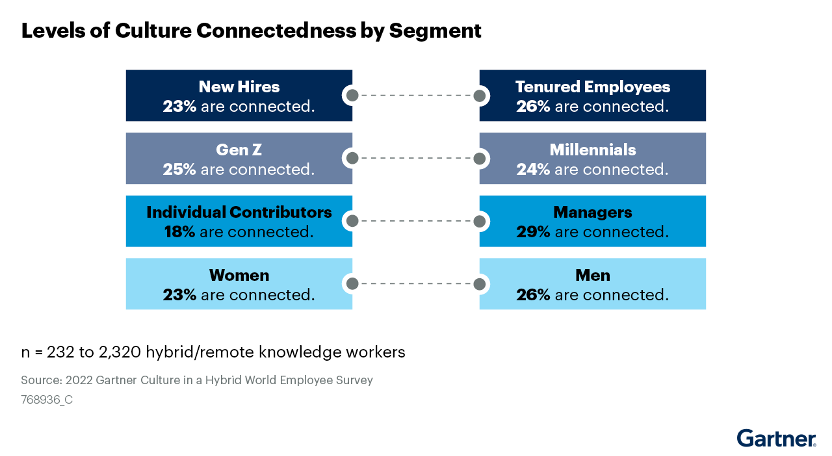Leadership
Culture in a Hybrid World
“Culture connectedness in the hybrid world is not compromised because of hybrid work but because companies aren’t intentionally driving it.”

As organisations plan and launch their post-pandemic work design strategies, many leaders are using organisational culture as the main justification for bringing employees back into the office.
These leaders worry without in-person experiences and time in employer-controlled spaces, connectedness to organisational culture is compromised.
However, the global remote work experiment has irrevocably changed the way culture is experienced by employees, requiring leaders to adapt to new realities of how culture is lived in the organisation.
At Gartner we believe organisational culture stems directly from the values shared by the organisation. It is the unwritten code of conduct made up of core values, cherished beliefs and priorities.
Executives must lead the way in connecting employees to organisational culture in the new work environment – and that means relying less on osmosis and more on intentional practices.
Hybrid work disrupts traditional culture
The COVID-19 pandemic forced many knowledge workers into remote settings and subsequently, as offices have begun to reopen, into a more hybrid work design.
Hybrid and remote work fundamentally change these hallmark cultural experience attributes:
Less time in offices — Hybrid or remote knowledge workers spend 65 per cent less time in offices than before the pandemic.
Fewer in-person interactions — Hybrid or remote knowledge workers meet their teams in-person two days a week on average, compared with four days a week before the pandemic.
Shrinking ecosystems — Hybrid or remote knowledge workers are interacting once a week or less with their “weak ties” compared with several times a week before the pandemic. (We define “weak ties” as peers from the organisation with whom an employee does not directly or indirectly work. For example, their manager’s manager, managers outside their team, leaders of their team or leaders outside their team.)
Many leaders view these changes as disruptions that will cause lasting harm on the impact of their culture.
Leaders have good reason to be concerned. Culture remains imperative for employees to succeed in their roles: 76 per cent of employees say culture is very or extremely important for them to be effective at their job. Sixty-one per cent of HR leaders say that to achieve organisational goals, culture is more important in a hybrid work model compared with an on-site work model.
Is culture “working”?
Many leaders define culture as “how we do things around here.”
With the changes that hybrid design brings to the cultural experience, the fundamental question becomes: What is culture when there is no one “how” and no one “here” anymore?
To answer this question, leaders must first elevate beyond the current hybrid reality and understand how to make a culture work to begin with. For a culture to truly succeed, employees must be aligned and connected to it.
The critical elements are:
1. Employees know what the culture is.
2. Employees believe the culture is right for the organisation.
3. Employees are able to demonstrate cultural behaviours.
Much of our research has been focused on how to successfully drive alignment to culture. However, the pandemic has unveiled the importance of the second measure, as it became clear connectedness was at risk.
Employee culture connectedness is also made up of three components:
1. Employees identify with the culture.
2. Employees care about the culture.
3. Employees belong within the culture.
Connectedness in crisis
Historically, senior leaders have been very intentional about investing in and driving alignment, whether through implementing culture training to teach employees about the culture, deploying resonant culture communications to help them buy into it or encouraging leader role modelling to help them demonstrate it.
However, leaders have been less intentional about connectedness.
The consensus approach to connectedness has primarily been one of “osmosis:” relying on time in offices, in-person and at a macroscale to make employees feel connected to culture.
One senior leader told us “our prior strategy for driving connectedness was mainly just ‘get employees aligned, and connectedness will happen’. In essence, we left it to chance.”
This “connectedness by osmosis” approach is severely compromised when the cultural experience changes and time in office, in-person and at a macro scale is no longer a guarantee.
Therefore, leaders often blame hybrid work for the connectedness crisis they are seeing, which is reflected in our data: 76 per cent of HR leaders feel hybrid work challenges employees’ connection to organisational culture.
Connectedness is currently in crisis: Only one in four hybrid or remote knowledge workers are connected to their culture. Across every segment of employees tested, connectedness scored low.

Naturally, leaders assume changes to the cultural experience caused these low levels of connectedness, which is why so many leaders are keen to nudge, or even force, their employees back into the office.
Sixty three per cent of HR leaders say their organisation will require employees to come into the office a certain number of days per week. However, our research shows this approach may backfire, as flexibility is actually a critical driver of connectedness.
Our data indicate the more flexibility an employee has, the more likely they are to be connected to culture.

Removing the flexibility employees have gained over the course of the pandemic is likely to have the opposite effect to the desired outcome: employees may become disconnected from culture.
Indeed, our data do not show on-site employees are any more connected than their remote counterparts; in fact, they are less culturally connected. Only 17 per cent of on-site knowledge workers are culturally connected, compared with 25 per cent of hybrid knowledge workers and 24 per cent of remote knowledge workers.
Connectedness not by osmosis
With these new imperatives in mind, leaders must shift their strategies to connect employees to culture more intentionally, moving away from relying on the office environment to do so by osmosis. To drive connection by intention, leaders must make three key shifts:
1. Shift from diffusing culture through the office to diffusing culture through work. While real estate investments to optimise office spaces remain important, this approach alone will only be half as effective, given that most knowledge workers will spend the majority of their time working from home. Instead, organisations should adopt the more holistic approach of identifying opportunities to enable employees to feel connected to the culture each time they engage with their work, which will be the new cultural constant regardless of location.
2. Shift from connecting through physical proximity to connecting through emotional proximity. As in-person interactions become rare, relying on employees being seen to drive connectedness is a risk. Instead, leaders should identify the moments where employees are most likely to feel seen — to feel emotional proximity — to connect them to culture.
3. Shift from optimising a macro-based experience to optimising a micro-based experience. As ecosystems shrink and relationships within them intensify, designing culture to be lived at the macro scale becomes less effective. Instead, leaders must equip teams to create vibrant and healthy microcultures, which create greater opportunities for connectedness.
Shifting from an osmosis strategy to a more intentional one is much more likely to drive connectedness.

And culture connectedness itself drives many of the talent and business outcomes leaders intuitively suspect but have struggled to quantify. Gartner research shows connectedness can increase employee performance by up to 37 per cent and employee retention by up to 36 per cent.
Culture connectedness in the hybrid world is not compromised because of hybrid work but because companies aren’t intentionally driving it.
Returning employees to the office by mandate is more likely to compromise connectedness to culture than preserve it.
Leaders must fundamentally change their culture strategy to reflect the realities of the new cultural experience.
And that is one reliant on fewer people, at a microscale, with less physical proximity and less time spent in offices. By relying less on osmosis to drive connectedness, and more on intentionality, leaders will see outsized impact on performance and intent to stay.
Neal Woolrich is Director, Human Resources Advisory at Gartner
Related Articles:
Inside ANZ
Be brave enough to leap
Inside ANZ
